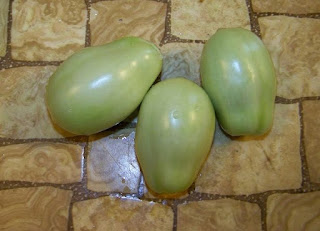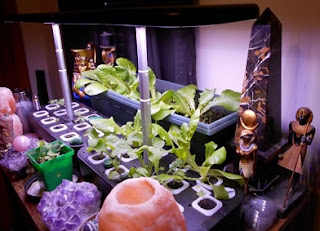Side Note: This is an old blog entry from another website of mine that I deleted. I decided to re-post it here because it fit the theme better than my other existing blogs. The original date of this post is sometime during the summer of 2011. I'll also include the previous comment field that was attached to it, at the end of this post.
As I mentioned on my “Garden Season of 2011” post, I was doubting if I’d even put out a garden this year – especially since I was moving, in between two houses, getting a late start, etc.
Well, I ended up planting a corn field over at the other place I left that was for sale, and a small tomato patch at the new house. Last year, the biggest garden pest I had was Japanese Beetles. Those pesky little beetles were eating the corn silks and part of the ears last year, but I planted my corn later this year and, for whatever reason, I didn’t have a problem with ’em this particular growing season. Actually, I figured they would be the type of garden pest that would get worse each year until I totally moved my crop to a different area. Anyway...
This year, and for the first time in my gardening career, I have had problems with my tomato plants. I’ve heard of cutworms or whatever, but I’ve never had dealings with Tomato Hornworms before! Those bastards can really do some damage, as they are some serious freakin’ gluts! Look below, for a couple pictures of those fat, green caterpillars with horns:
Yeah, they are fat, green, and have a red horn sticking out – near their bunghole region. Of course, a lot of people may be looking for the “how to remove” advice, but I’m going to keep it short. Personally, other than the enjoyment of working in a garden, I mainly grow the food I plant to have organic produce from fertile soil that, in return, has a full, rich flavor that you can’t find at your common grocery stores. So, I manually remove these garden pests when possible and go ahead and accept the fact that some of my yield goes to the insects and animals, etc. But what is left, will be totally organic.
Now, if you are a big fan of insecticides and poisonous sprays, I recommend that you get one that is especially formulated for caterpillars – if Tomato Hornworms are your problem.
These green, hungry devils eat like crazy; they eat the tomatoes and the plant itself. It often looks like somebody went by and trimmed your plant with scissors. However, they are not cutworms, but similar; cutworms usually cut your plant off close to the base. To rid yourself of them, it is good to not let the weeds build up around your plants, which act as a breeding ground, till the ground as often as needed, and to place tin foil, cardboard, etc., around the base of your tomato plants. Of course, there is insecticide for cutworms, as well; I just try to steer clear from poisons and chemical sprays. Hell, if I wanted my garden to be full of chemicals, I’d just not ever plant anything and would buy all my produce at the local market.
Well, I mainly wanted to do a quick post over the Tomato Hornworm in case people are out there searching online using phrases like “these damn green worms are in my garden and eating my tomato plants,” etc. If I would have kept a check on my tomato patch more often, I could have removed them quicker and less damage would have occurred.
At any rate, good luck with your crops! Cheers!
Update (8-7-2012): Due to a special request/question in the comment field, below is a picture of what the Tomato Hornworms ultimately turn into, which is a Five-spotted Hawk Moth:
---The original comment field, below:
Comment#1:
Nancy says:
July 1, 2012, at 5:54 pm
Thanks for solving the mystery for us of what kind of caterpillar ate the top half of our two tomato plants. My husband found it hanging on to one of the stalks one night, it was huge and looks just like your photo! I had looked for days and never saw him cuz his bright green color blended exactly with the leaves. I just must have overlooked him. He had a feast in the meantime…
Comment#2:
Amanda says:
August 6, 2012, at 7:12 pm
We found a HUGE one of these on our tomato plant today. It didn’t really eat much. Just one branch. Our son just loves all of nature and animal life and totally freaked when his daddy wanted to kill it. He insisted on carrying it to the opposite side of the road and letting it go in the cotton patch. He’s 6 and saw on the television that caterpillars turn into butterflies. Does this thing turn into a butterfly? If so, it may very well have a foot long wingspan given the size of the worm.
Comment#3:
Administrator says:
August 7, 2012, at 11:07 am
Tomato and tobacco hornworms are large caterpillars, up to four inches in length. The prominent “horn” on the rear of both gives them their name. They can quickly defoliate tomatoes, potatoes, eggplants and peppers. The adult of the tobacco hornworm is the sphinx moth. The five-spotted hawk moth is the adult of the tomato hornworm. Both moths are stout-bodied, grayish-colored insects with a wing spread of 4 to 5 inches. They’re not exactly pretty butterflies but are large and striking.
Thanks to your comment, I will add an image of what the tomato hornworm ultimately turns into, at the bottom of the original article. Cheers!
Comment#4:
Amanda says:
August 7, 2012, at 2:48 pm
Thanks for your reply and the pic of the moth. My son said it was “awesome.”
---End of the original comment field
Update: (11-12-2024): Since it has been over 13 years since I originally wrote this post, I thought I'd add a few tidbits about this creature, since I'm republishing it here. I will briefly talk about a crazy invasion I once had with tomato hornworms, an alternative solution for organic gardening (natural insecticide) to combat this green caterpillar, and a predator of this pest that you should always let thrive.
Tidbit #1 - A few years ago, I got lazy at the end of my garden season. I usually cut down the plants, clean up the garden area, mow, till again, etc., before waiting until the next year. Well, the tomato hornworms were bad that particular year, but I was so busy with work, I let them live instead of pulling them off, one at a time. By the end of the season, I decided I'd let them eat down all the plants to save me time cutting them all down. That was a mistake! Never do that! I'm not joking when I say this, but there was a time when there were so many of them out there, if I paused to listen, I could literally hear them eating! I spent way too much time the next year fighting them off of my tomato plants. My tomato hornworms kill-count was in the triple digits the following year, trust me...
Tidbit #2 - I've only used this a couple of times over the years, but there is supposedly an insecticide alternative for organic gardeners that are trying to fight certain types of garden pests like worms & caterpillars. It is a biological (bacterial) insecticide called "Monterey B.t." The active ingredient as listed on the package: Bacillus thuringiensis subspecies kurstaki strain SA-12 solids, spores and Lepidopteran active toxins (At least 6 million viable spores per mg).
Tidbit #3 - If you ever see tomato hornworms on your plants that seem motionless and are covered with little white things that look like rice, leave it alone and do not destroy anything. Those come from the Braconid wasps. They will lay their eggs on these particular garden pests and the larva will eat the tomato hornworms from the inside out. If left alone and the process completes, these Braconid wasps will get to reproduce. This will allow for even more of them to be out there to do the same thing again. They are probably the best natural predator for these things, overall.
Tidbit #4 - This is more of an observation than anything informative, but I have always noticed that the tomato hornworms that eat off of my pepper plants are always a darker green than the ones that eat the tomato plants. I can only assume the different nutrients affect the hue.
Well, that about wraps it up for now...
---End of Post "Garden Pest: Tomato Hornworms"





















